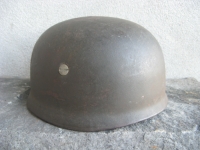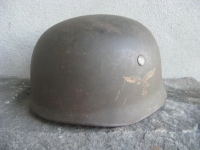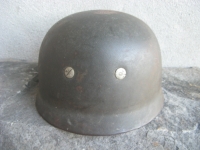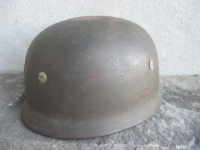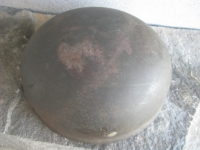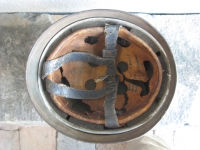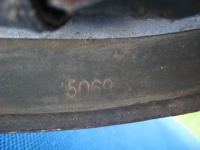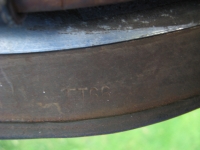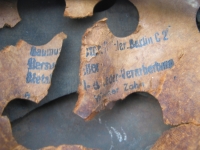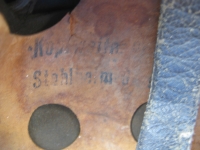M1938 Luftwaffe Paratrooper (Fallschirmjäger) German Helmet
This is a good solid example of mid war 1940 M1938 Luftwaffe Fallschirmjäger (Paratrooper) German Helmet. The exterior of the helmet retains 85-90% of its original Luftwaffe blue textured factory paint with no cracks, dents or rust pitting making it a very solid all around shell indeed. The helmet retains all four of the original slotted aluminum bolts. The bolts all retain the hex nuts. The leather liner is in fair overall condition with some light wear and tears. The liner is maker stamped Heisler, Berlin and is size stamped 55/56. The shell is stamped ET66 indicating manufacture by the Eisenhuttenwerke firm in Thale, Germany. The lot number is 5069 suggesting a mid-war production date of 1940 according to Brian Ice's lot data book a must for any collector. The Luftwaffe decal is in excellent overall condition and has aged nicely into the shell - a great feature since many late war M38's are plain Jane's with no decal having been added. A practice which halted around 1943 till the end of the war.
The chinstrap harness was most likely cadaver cut as the chinstrap appears to have been crudely cut in the same section what would have rested under the German's chin. Nearly all paratrooper units saw heavy action during WW2 and so M38 helmets are often found to been taken from fallen German soldiers still wearing them.
This helmet came from a shrimp boat Captain in South Carolina named Bo Harken who told me that he found it in 1974 when his father had him clearing out an old cabin on the water that they had purchased to launch their fishing boats. It was inside a closet in an army duffel bag and unfortunately he has no further information on who owned the cabin or how exactly the helmet go there. A great find in any event having that it hasn't seen the light of day for many years and has never been seen online previous to now.
$3350 SOLD
BACKGROUND HISTORY FOR YOUR OWN GENERAL INTEREST
On 29 January 1936 Hermann Göring established Germany’s first parachute training school at the Luftwaffe base in Stendal. The men were reorganized into the I. Battalion and the 15 (Pioneer) Kompanie of what was to become "Fallschirmjäger Regiment I". Likewise on 1 April 1937 the Army formed a parachute company which also trained at Stendal. A new protective helmet was need for parachute jumps and the firm of Eisenhüttenwerke in Thale undertook the initial prototype design. The result was a helmet with the cut-down appearance of a standard M1935. This helmet was soon introduced for general use in 1936.
The Model 1936 Parachute Helmet (M1936) was made of steel in the general shape of the M1935 helmet but without the extended brim and flared sides. It utilized a three rivet M1931 liner retaining system like the M1935 but with a modified eight-finger leather liner and heavy foam pad in the crown. Like the M1935, the helmet used the same hollow rivets for air vents. The unique chinstrap was designed to cross behind the back of the neck and down around the chin while crossing on either side of the ears. Four reinforced oblong slots in the helmet shell allowed the wearer to hang the carbine hooks on the sides of the helmet when it was not used for parachute jumping.
In 1937 an improved helmet shell was introduced that utilized the same components as the M1936. The Model 1937 Parachute Helmet (M1937) was nearly identical to the M1936 with the exception that it had two, rather than four, non-reinforced oblong slots in the helmet shell. Under sustained use the early lining system proved faulty as the three split rivets combined with the aluminum M1931 liner band tended to warp or shear. Subsequently the helmet underwent modifications that resulted in the introduction of the improved Model 1938 Parachute Helmet (M1938).
The M1938 helmet incorporated four hollow-bore spanner bolts (with screws and hexagonal washers) in favor of the three split-tailed rivets found on the M1937. The liner system was completely redesigned with heavy rubber padding on the sides and crown with an improved aluminum liner band ring. Later models incorporated a zinc plated steel ring instead of aluminum. Helmet sizing was achieved by varying the thickness of the rubber padding in the appropriate sized helmet shell. The support lining was now constructed out of two pieces of leather sewn together in the center in which twelve holes were cut to allow for venting.
The M1938 helmet was constructed in four different centimeter shell sizes (64, 66, 68, 71). The shell was stamped with four holes where the lining could be attached to the helmet shell using spanner-bolts. Original examples are stamped with "ET" or "ckl" representing both trademarks used by the Thale manufacturing facility. No other revisions to the basic design were introduced after 1938. Early helmets bore a double decal configuration consisting of the Luftwaffe eagle and the National tricolored shield of Germany. The German Army (Heer) also used the standard Armed Forces Eagle insignia (Wehrmachtsadler) for a very short time before being integrated into the Luftwaffe.


